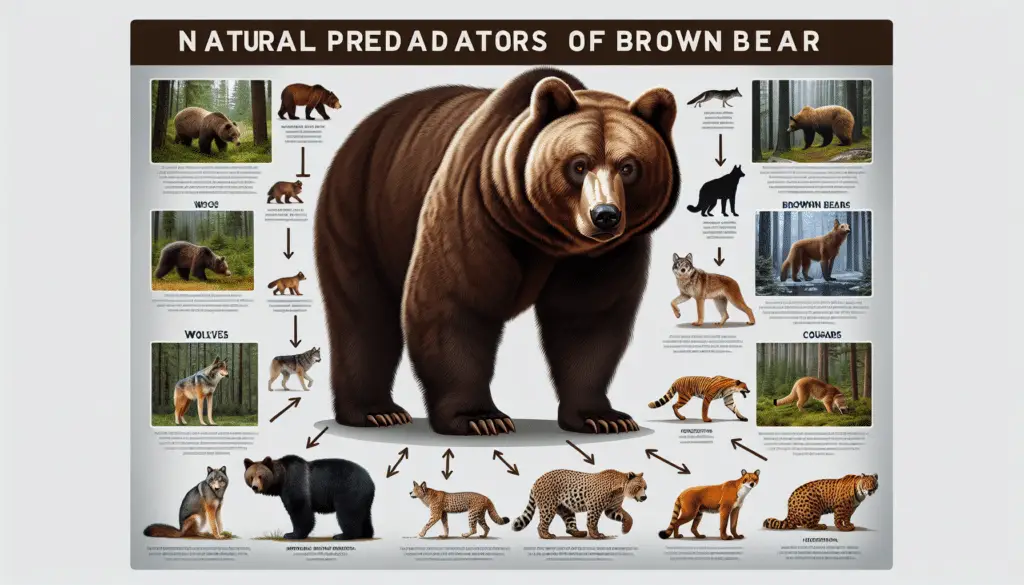Natural Predators of Brown Bears
Table of Contents
ToggleIn the wild, brown bears sit at the top of the food chain with a limited number of natural predators.
However, when natural predators do pose a threat to brown bears, they are generally other large carnivores.
These potential predators include other bear species, wolves, and in some rare instances, large felines such as Siberian tigers.
Inter-bear Predation
One significant threat to brown bears, especially cubs and subadults, comes from within their own species.
Male brown bears, known as boars, can be a threat to cubs that are not their own and sometimes even kill them.
This act, known as infanticide, is typically a male’s attempt to bring the female into estrus and spread his own genes, ensuring his lineage.
Wolves as Predators
Wolf packs can sometimes pose a danger to young or vulnerable brown bears.
While adult brown bears are formidable and typically avoid confrontations with wolves, cubs separated from their mothers can be at risk.
In areas where wolves and brown bears coexist, such as Yellowstone National Park, encounters between these apex predators can occur, though typically wolves avoid hunting brown bears due to the risk.
The Threat of Siberian Tigers
Cases where brown bears are hunted by large felines are extremely rare but not unheard of.
In parts of Russia, the Siberian tiger is known to hunt and kill brown bears.
This largely happens in the Siberian taiga, where food scarcity forces apex predators to compete, often leading to deadly encounters between these species.
The Impact of Young Bears on the Ecosystem
Understanding the role of apex predators like brown bears in the ecosystem is important as it offers insight into the delicate balance of nature.
Brown bears are keystone species that help to maintain healthy ecosystems by controlling other animal populations and helping to distribute nutrients through their foraging habits.
Other Potential Threats to Brown Bears
Aside from natural predators, brown bears face threats from humans and environmental factors.
Human activities such as habitat destruction and poaching have severe effects on brown bear populations worldwide.
As human settlements expand into bear habitats, encounters become more common and can be deadly for bears.
Conservation Efforts for Protecting Bears
Efforts to protect brown bears involve creating and enforcing wildlife reserves, regulating hunting, and developing bear-aware communities.
Conservation groups work globally to ensure that bear populations are sustainable, reducing the chance of bears becoming endangered or extinct.
The Challenge of Human-Bear Conflicts
Human-bear conflicts can arise from bears wandering into urban areas in search of food.
One way to mitigate these conflicts is by using bear-proof containers and educating local populations on how to store food safely.
Bear-Proof Products and Solutions
Bear-proof products have been developed to help prevent bears from accessing human food sources, subsequently reducing the risk of bears becoming habituated or aggressive towards humans.
One such product is the BearVault bear-resistant food canister, which has received positive reviews for its durability and effectiveness in the field.
Pros
- Highly durable construction prevents bears from breaking in.
- Transparent design allows for easy identification of contents.
- Lightweight and portable, making it simple to carry on backpacking trips.
Cons
- Can be challenging to open without instructions, especially in cold weather.
- Some find the capacity to be limited for longer trips.
- More expensive than traditional food storage methods.
Many hikers and campers who frequent bear country have praised the BearVault for its reliability.
Others have noted that while initial usage can be tricky, once they got the hang of it, the canister was straightforward to use.
Despite its price, it’s said that the BearVault’s effectiveness in keeping both bears and food safe makes it a worthy investment for outdoor enthusiasts.
Find This and More on Amazon
Human Encounters with Brown Bears
Encounters between humans and brown bears can sometimes turn into a form of predation, albeit through conflict rather than natural prey selection.
In regions where brown bears are found near human populations, such as Alaska and parts of Europe, occasional conflicts can arise, particularly when bears are tempted by improperly stored garbage or crops.
Although rare, serious human-brown bear encounters can result in human fatalities.
Predator Control Measures for Brown Bears
In some areas, wildlife management practices include predator control measures which may affect brown bear populations.
This can involve the removal of individuals deemed a threat to livestock, property, or human safety.
Methods used can range from live trapping and relocation to lethal means, though many conservationists argue for more ethical and sustainable approaches.
The Role of Brown Bears in Their Ecosystem
Brown bears play a crucial role in maintaining ecological balance by impacting populations of other species, such as hoofed mammals.
Their foraging behaviors also contribute to seed dispersal and nutrient cycling in forests and other habitats.
Climate Change and Brown Bear Survival
Climate change is emerging as an indirect predator by altering the habitats and prey availability for brown bears.
As habitat conditions change, the bears must adapt to shifts in food sources which can affect their health and reproduction rates.
The changing climate may also lead to increased interactions with other predator species adapting to the same conditions.
Human Impact on Predator-Prey Dynamics
Human activities such as overhunting of prey species can affect the natural predator-prey dynamics involving brown bears.
When prey becomes scarce due to overharvesting, this can force bears to expand their foraging territories, sometimes leading them to seek food in human-inhabited areas.
Such scenarios increase the likelihood of bears becoming nuisances or viewed as predators of livestock, intensifying human-wildlife conflict.
Cultural Significance and Misconceptions
In some cultures, brown bears are revered and feared, sometimes leading to misconceptions about their behaviors and threat level.
Education and outreach programs aim to dispel these myths, teaching people about bear behavior and promoting coexistence.
Understanding the reality of bear predation contributes to improved safety for both humans and bears.
Technologies for Monitoring Bear Activity
Modern technologies, such as GPS collars and camera traps, allow for the monitoring of brown bear activity and movement.
This data is invaluable for wildlife biologists seeking to understand predation patterns, habitat use, and potential conflicts with other predator species or humans.
Exploring the Diets of Brown Bears
While brown bears are omnivores and typically prefer a diet of nuts, berries, and vegetation, they can also be opportunistic predators.
Depending on the region, their diet may include fish, particularly salmon during spawning season, small mammals, carrion, and occasionally young ungulates, such as deer fawns.
Wildlife Photography and Brown Bear Observation
The allure of witnessing brown bears in their natural habitats is significant for wildlife photographers and enthusiasts.
By following guidelines and employing long-range photography equipment, individuals can safely capture images of bears without disturbing them or risking an encounter.
Tools for Bear Safety
For those living in or visiting bear habitats, bear safety tools are essential.
Items such as bear-resistant garbage cans and electric fences can be incredibly effective in deterring bears from accessing human food and reducing dangerous interactions.
The Importance of Protecting Bear Habitats
Maintaining and restoring natural habitats is a critical step in ensuring the survival of brown bear populations and reducing predation pressures on them.
Protected areas provide safe zones for bears to forage and breed without the risk posed by humans or other predators.
Frequently Asked Questions
What impact does bear viewing tourism have on brown bear populations?
Bear viewing tourism, when managed responsibly, can have minimal impact on brown bear populations and provide economic incentives for conservation.
Are there any non-lethal ways to protect livestock from brown bears?
Yes, practices such as using guardian animals, installing electric fencing, and proper carcass disposal can help protect livestock without harming bears.
How do researchers track the population sizes of brown bears?
Researchers use a combination of methods, including DNA analysis from hair and scat samples, visual surveys, and tracking technologies like radio collaring.
What steps can campers take to avoid attracting brown bears?
Campers should store food in bear-proof containers, dispose of waste properly, and keep their campsite clean to reduce the risk of attracting bears.
What should you do if you encounter a brown bear in the wild?
If you encounter a brown bear, remain calm, avoid eye contact, back away slowly, and do not run; if the bear approaches, speak in a firm tone and use bear spray as a last resort.
Are brown bears endangered?
Some brown bear populations are healthy, while others, such as the grizzly bear in the contiguous United States, are considered threatened and are protected under the Endangered Species Act.
Do brown bears play any role in controlling deer populations?
While not a primary food source, brown bears will prey on deer if given the opportunity, contributing to natural population control.
How can I safely watch brown bears in the wild?
To safely observe brown bears, maintain a safe distance and never approach or feed them; consider using binoculars or a zoom lens for a closer view.
Can bear sprays effectively deter an attacking bear?
Bear sprays are a recommended non-lethal deterrent that can be effective at stopping aggressive behavior if used correctly.
How does deforestation affect brown bears?
Deforestation results in habitat loss, reducing food availability and safe havens for bears, and increasing encounters with humans.



